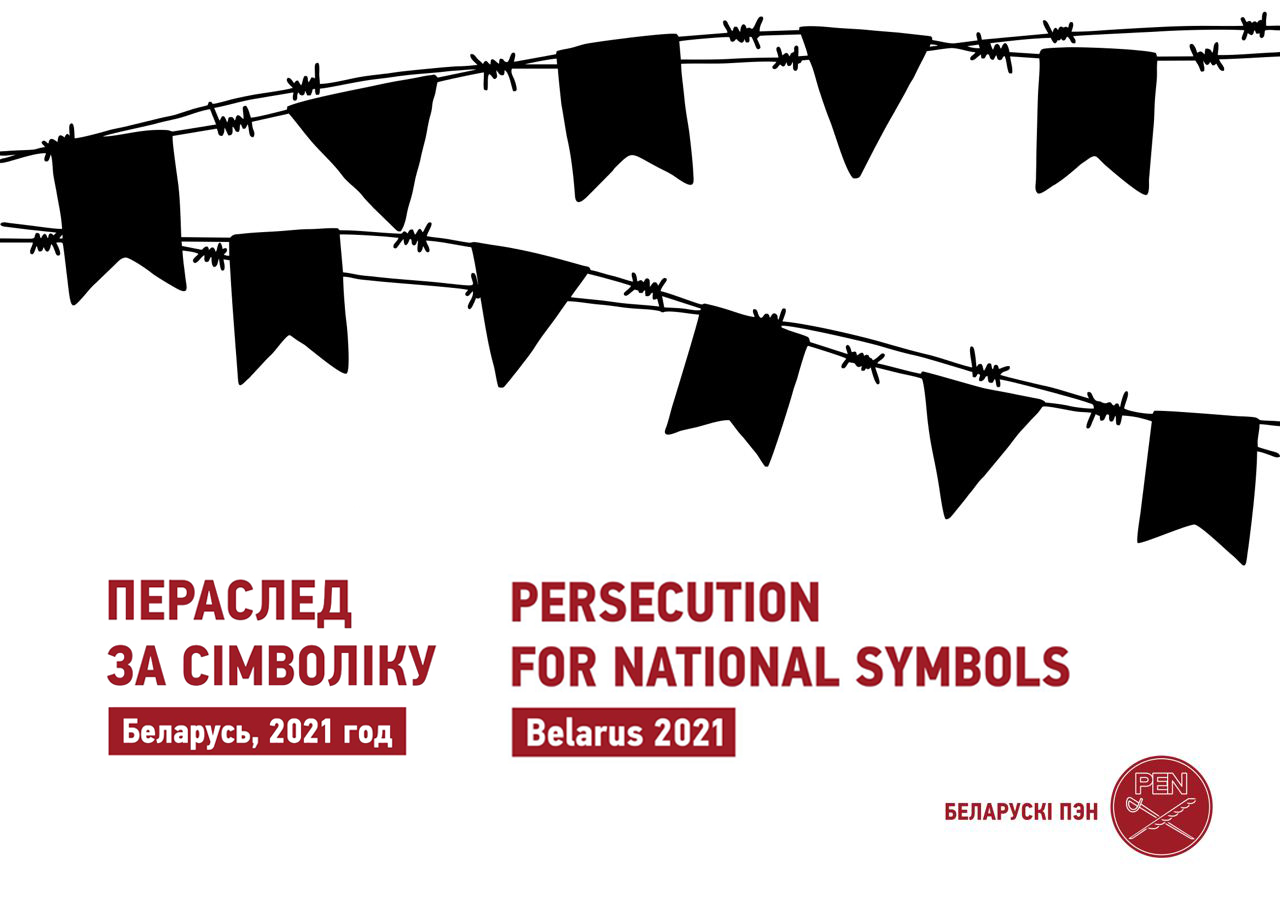
The present monitoring is a continuation of the base document by PEN Belarus about the implementation of cultural rights as they relate to culture workers (Right for Culture. Belarus 2021) and is dedicated to the subject of persecution for the use of [non-forbidden] symbols. In particular, we are focused on the white-red-white flag and the Pahonia coat of arms. Facts about the repression of cultural workers was the main focus in our primary monitoring document, whereas the focus of the present document is not those who do work professionally in a cultural sphere, but instead those whose rights to use national symbols were violated in 2021. We will not evaluate the rhetoric of government media and officials in the context of how these symbols (the white-red-white flag and the Pahonia coat of arms) are defamed and discredited; rather, the primary purpose of this monitoring is to provide statistics about these violations. Also, we will dwell on criminal cases, initiated en masse, against those who caused damage to the official state [red and green] symbols, and pay close attention to the symbolic fight within the conditions of urban space overall, where any manifestation of the white and red is totally eliminated or repainted with the colors of the state flag.
I. RIGHTS INFRINGEMENTS REGARDING THE USE OF WHITE-RED-WHITE SYMBOLS
Here is some brief historical information about the white-red-white flag [1]:
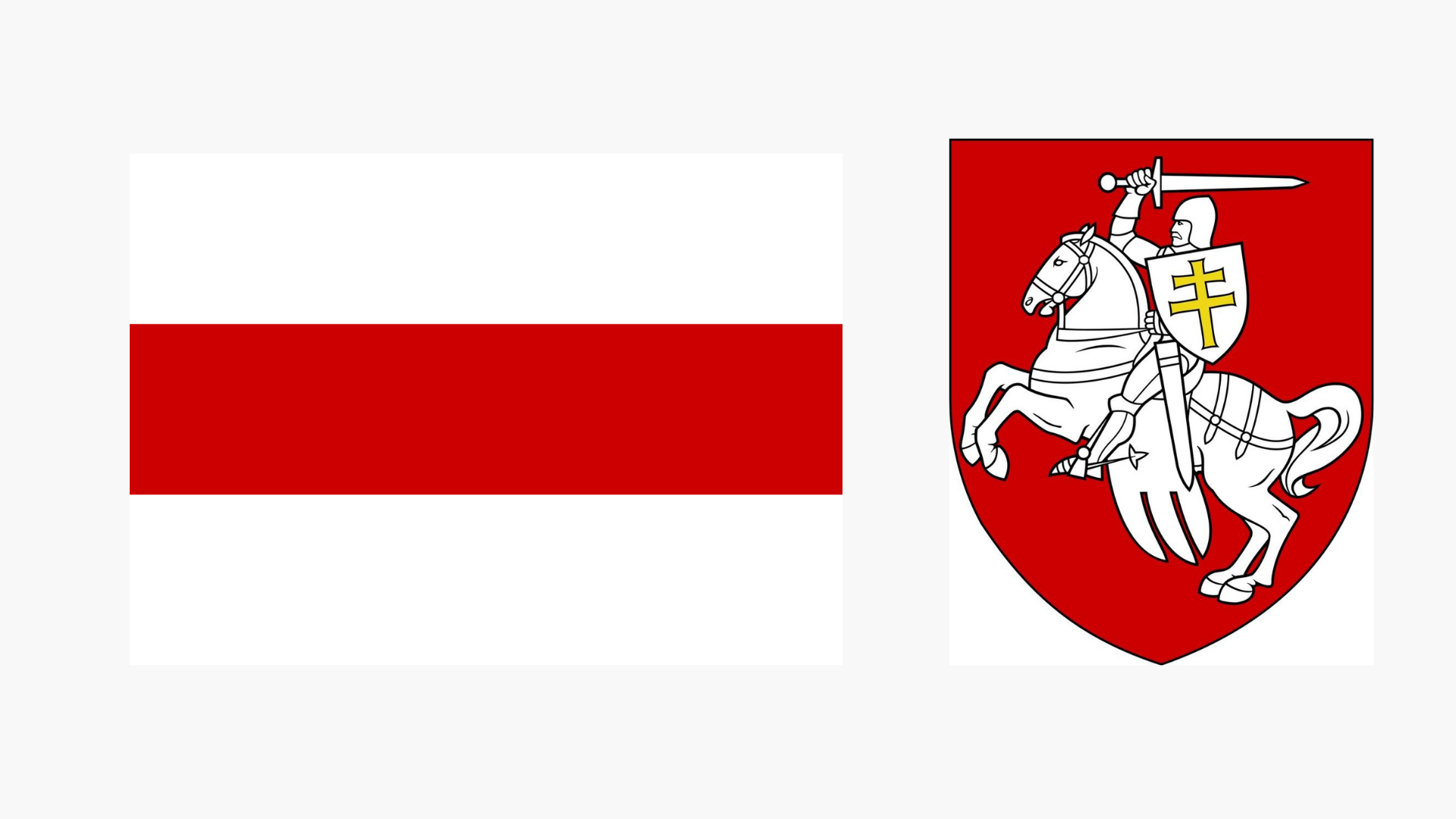
Approved on March 25, 1917 in Minsk during the first Belarusian congress.
The official flag of the Belarusian People’s Republic, 1918–1919.The official flag of the Republic of Belarus, 1991–1995.
White and red are characteristic of Belarusian culture. Red elements on a white base are considered to be the most common color combination in Belarusian ornaments. White and red are also the colors of the national coat of arms Pahonia (1918–1919, 1991–1995).
The white-red-white flag became the main symbol of protests held in response to falsified results in the August 2020 presidential elections and to the unprecedented violence towards those protestors who had stood up for truth and change. The street protests from August 2020 – early 2021 were crushed by the state security apparatus, but the flag and the combination of red and white continue to be important national symbols used by residents of Belarus and its diaspora around the world to represent the struggle for freedom and social change.
In 2021, our monitoring tracked 335 cases of rights infringements in response to the use of white-red-white symbols among 323 people and 3 cases of repression of organizations and communities (2 residents associations and one restaurant).
Geographically, the repression occurred across the whole country:
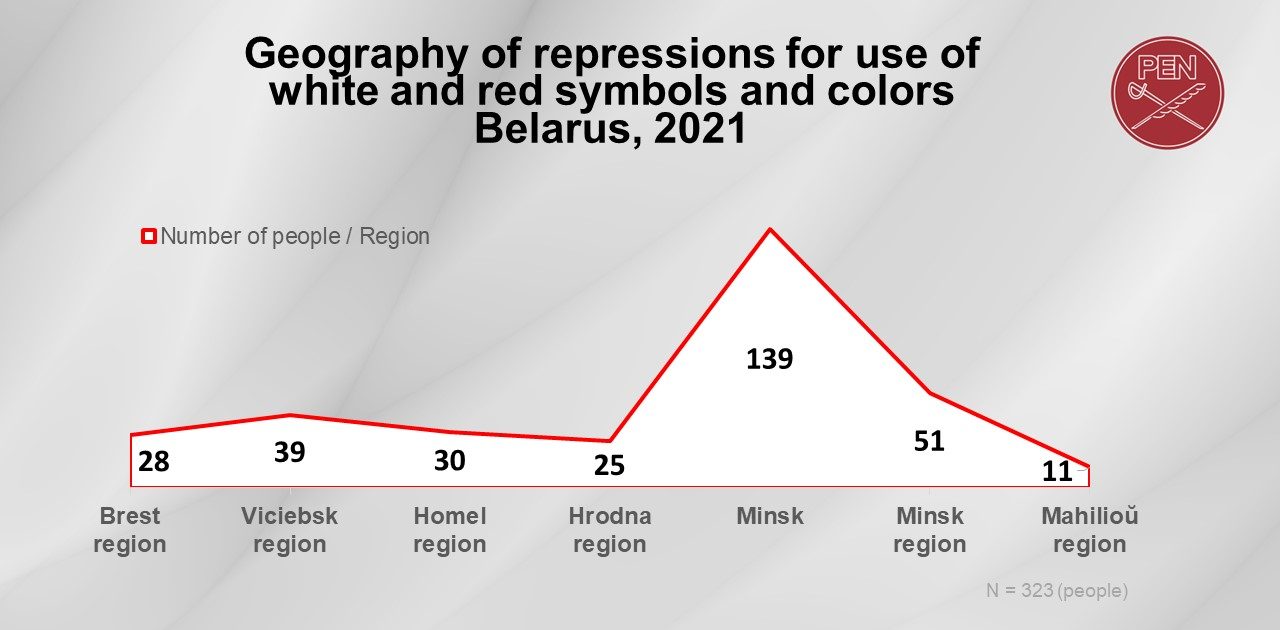
How people expressed their civic positions and how, at that same time, their actions served as a pretext for detention and repression:
A white-red-white flag, hanging from your balcony or window, draped on your shoulders during a procession, hanging from the well on your own farm or from the roof of a private home; a white-red sign with the name of a street and the number of a house or a white-red fence section on a private plot; the image of a rider on a white and red background, placed on the inside of a fence or the facade of a garage; a snowman made in the yard of a dacha and decorated with a red scarf; a weather vane on the roof with the “Pahonia” coat of arms; a photograph of a white-red-white flag depicting the coat of arms of the city of Luninets, posted online; a photograph with white and red attributes found in a personal correspondence or on a flash drive during a search; a decorative gnome with a white-red-white flag in his hands on the windowsill; white and red paper hearts on the window; blinds or a garland on the window, or curtains with traditional Belarusian ornamentation; hanging a white blanket or underwear with a red stripe on the balcony to dry; a white and red box from an LG TV; a white-red-white flag in a car window or a sticker with the “Pahonia” crest on the bumper; white-red lights at the entrance to a residential building; red and white clothing; red sneakers; a backpack with a “Pahonia” crest badge; white and red flowers or balloons; ribbons on a fence and red hearts in the trees; white and red doodles and inscriptions on telephone poles, trees, kiosks, and asphalt; white A4 paper with a painted red stripe; “Long Live Belarus!” written on the sidewalk or heard from the window of an apartment building, and more.
“They told me that a photograph with the flag was one step from making Molotov cocktails and throwing them at law enforcement officials”, Ekaterina Borodaeva said regarding her experience in detention. She was fined 435 Rubles (approximately 140 euros).
The main “protest”-related (which has become “of the people” for Belarusians since the summer of 2020) article in the Code of the Republic of Belarus on Administrative Offenses (Administrative Code of the Republic of Belarus) is Article 23.34 (24.23 in the new edition [2]). It reads: “The violation of the procedure for organizing or holding mass events“. This is the article according to which thousands of participants in peaceful protests were ‘brought to justice’; it is the article according to which people were detained, beaten, tortured, put in jail for days, and fined. By the end of 2020, street protests ceased to be massive, but “unauthorized picketing” acquired new forms and styles in the eyes of the state incarceration complex. Any use of a white-red-white flag, and the combination these two colors more generally, were equated with protesting.
For example, in some cases, detainees were charged for picketing “by distributing sweets in a white-red-white wrapper“, or “by using a white-red-white “Barsuk” picture“, or “by having a white-red-white sticker on a bicycle alongside the image of a three-headed dragon and the inscription “Tsmok-Zmagarych””. They were detained for putting snowflakes on their windows, for using curtains covered in red and white flowers, for wearing “political” colors, for having a painted red stripe on a construction helmet, for possessing a flag of Canada or Japan, or for having an umbrella with the inscription “Polska” (in this case, the detained was a pensioner on a walk). The “picketing” objects included white-red-white socks, car decorations in “oppositional” colors, the coat of arms of Lithuania on the glass of the rear door of the car, and a house’s pediment painted white and red. They were punished for “picketing by drawing a heart in the elevator of a residential building“, and for “placing stickers on the window in the form of clouds, tulips and daisies of white-red-white color, ultimately forming a white-red-white flag“, as well as for hanging white-red-white towels on a balcony “to demonstrate civil and political interests“. Picketing came to mean: a sticker on a laptop or mobile phone; posting a white-red-white flag emoji in a Telegram channel; a white sheet of paper on the glass of the balcony, or even a white transom window with an orange ribbon pasted on it; an inscription on the balcony reading “this is not a flag“; the launch of a two-tone fireworks display; and hair dyed white and red. It is such that the socio-political situation across the country can be disrupted by a certain color of a person’s pants. Also, this “illegal picketing” even took place when using the white-red-white flag in a deserted forest area, or elsewhere where it would not be seen.
Under “The People’s Statue,” officials detained people of various professions – teachers and bloggers, department assistants and pensioners, activists and bookkeepers, journalists and investors, pediatricians and businessmen, etc. – and of various ages, from minors (13-year-old Jaŭhienija Varačkoŭskaja, having written «ЖЫВЕ» on a walking path, had violated “the procedure for hosting a mass event”, according to the protocol) to 75-year-old pensioners (activist Anatol Kulik repeatedly violated administrative article 23.34 by going out into the city with a flag draped over his shoulders and placing red and white curtains on his balcony).
On the whole, there are stories in which people were detained without any evidence of their involvement (allegedly for an action using symbols or on the basis of photos and videos on which it is impossible to identify faces because they are covered with masks). Sometimes, the detained were random passers-by who found themselves near previously hanged ribbons on a fence, a sticker already glued to a post, or an abandoned package in the forest that turned out to contain two white-red-white flags. Sometimes, the detained were held responsible for a coat of arms, a flag, a sign or a sticker that had been fastened to a place many years before, long before any of the events described. Oftentimes a flag was found during a search or posted and photographed by the security forces (which is a “convenient” and oft-practiced way of justifying the punishment of persons who have not committed any illegal actions).
The general picture of repression cases for use of white-red-white symbols, as well as any combination of these colors recorded in this monitoring, is as follows:
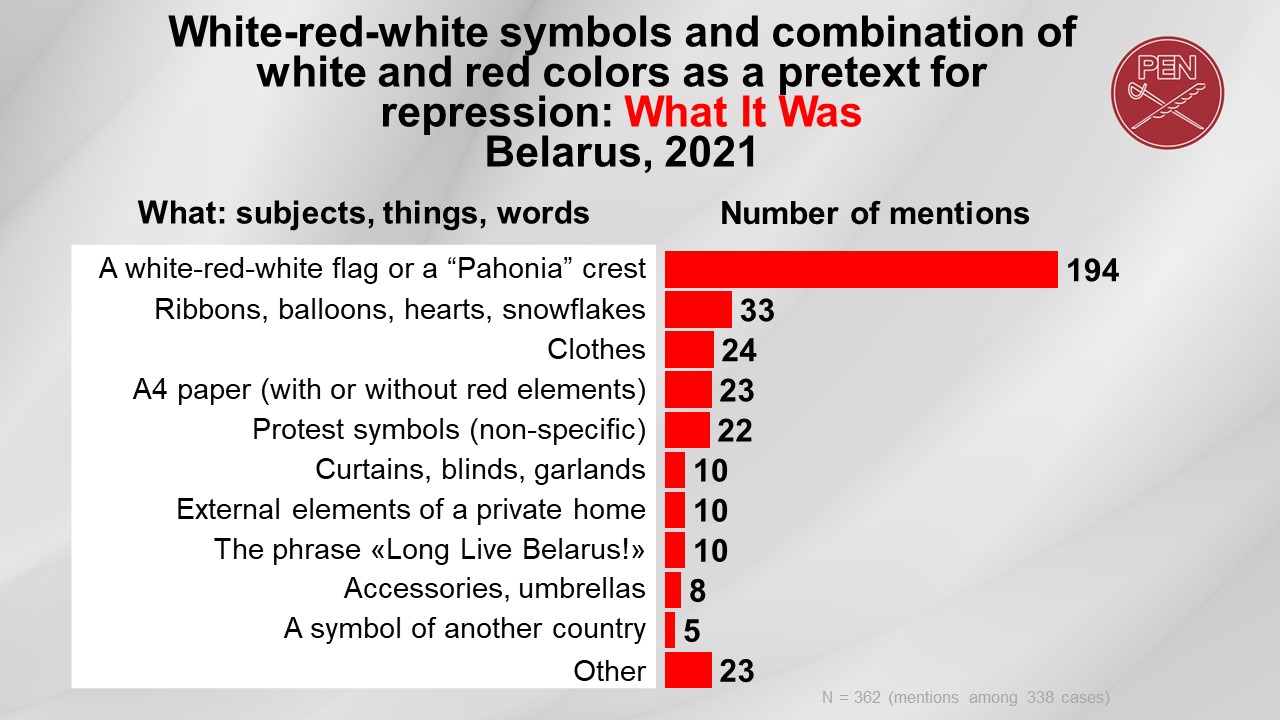
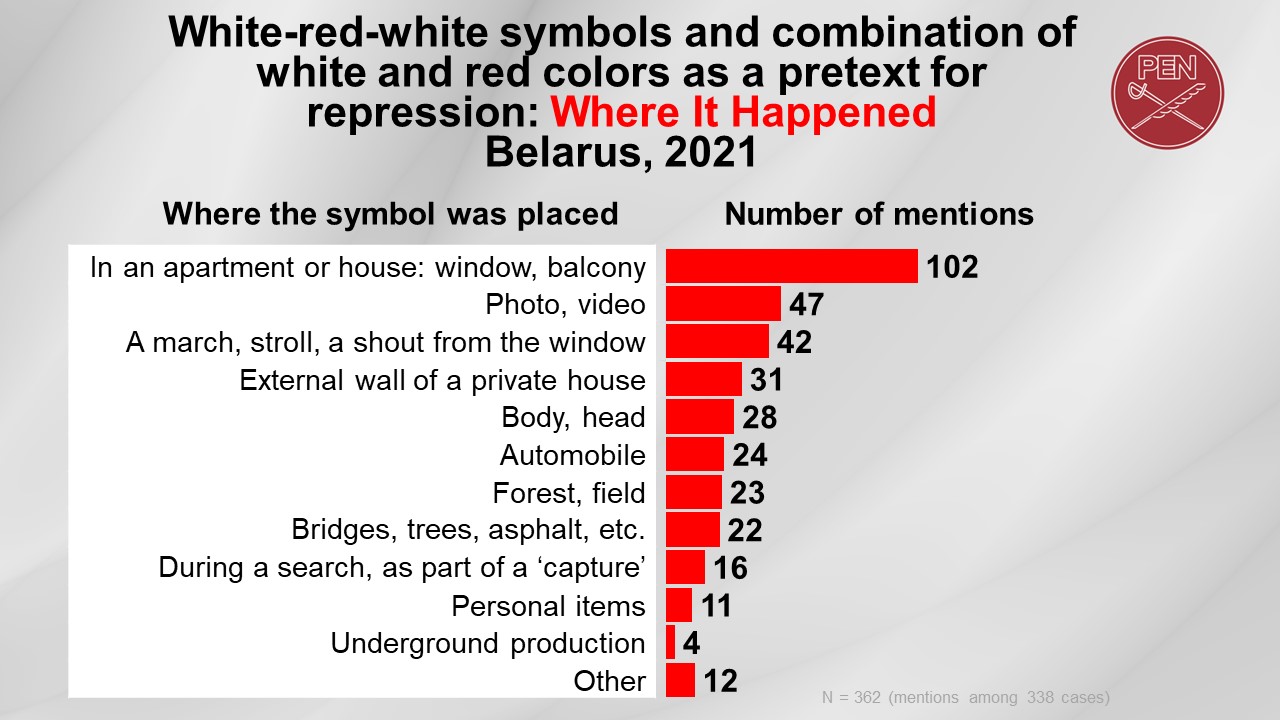
In the majority of situations in which people were detained for the use of white-red-white symbols or combining white and red, individuals were subject to administrative protocols involving a prison sentence or a fine.
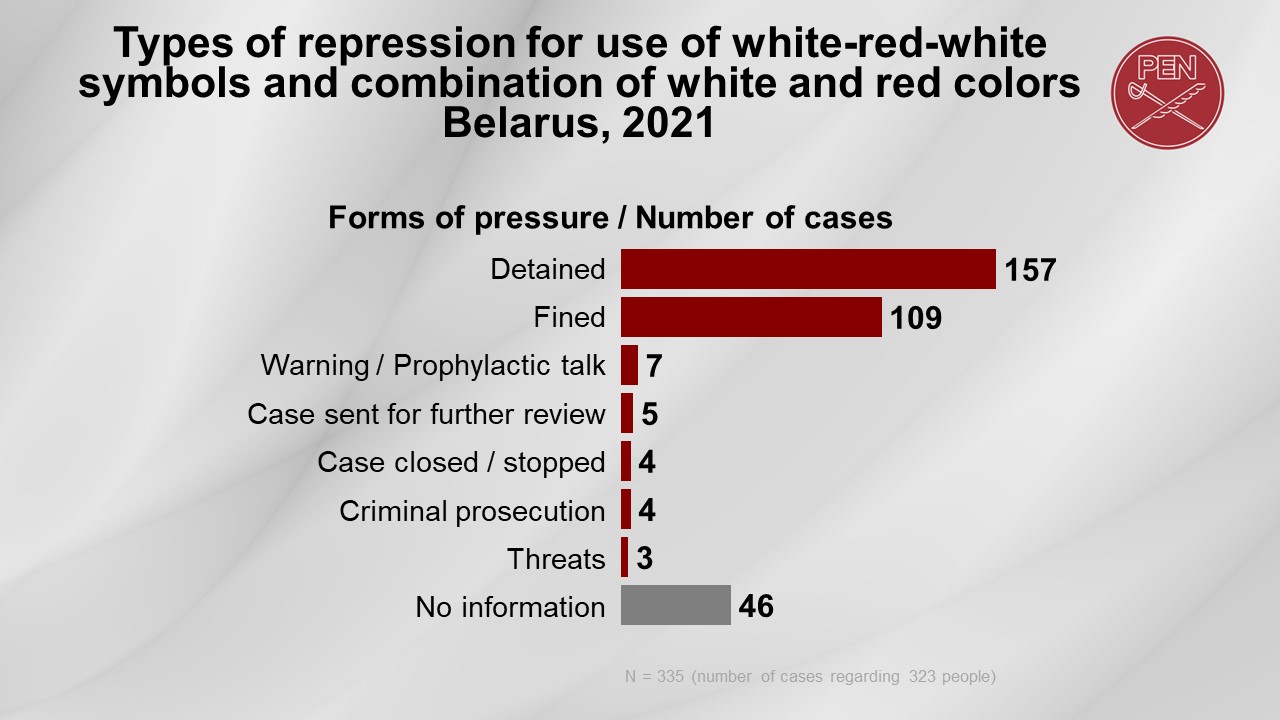
Among 335 recorded cases, the outcomes of 289 are known. Of those, in at least one in two (54% of 289 known outcomes), the case closed with a prison sentence of between 3 and 90 days. One in three (38%) included a fine of between 7 and 200 base currency units (from 65 to 1870 euros). In 19 cases (7%) the case was closed, and the outcome was either a warning or a threat.
«They told me in the police station that the combination of white and red is forbidden in this country, and so is any depiction of the Pahonia crest. I asked: is it possible that everything is forbidden, including thought? They replied that one can think as they please, but there’s no need to express it”, Vieranika Drabyšeŭskaja remembered of her conversation at the detention center. She was fined 2900 Rubles (approximately 940 Euros) in August for posting Pahonia and Long live Belarus (Жыве Беларусь) stickers in a Telegram channel called “Dobrush for Life.”
Out of all residents of Belarus detained for the use of white-red-white symbols and variations of white and red colors on their clothes, drawings, stickers, and so on, they spent a combined total of at least 2 589 days [3] in prison and were fined a total of 53,000 Euros [4].
In addition, during an arrest or period of detention, many were subjected to torture and/or were forced to confess on camera, under pressure. Characteristic of these “repentance” videos is that they often take place in front of a red-green flag, and the final videos are posted on pro-government Telegram channels for the purpose of intimidation. Seizures of personal belongings (laptops and tablets, cellphones, jewelry, cars, flashdrives, keys, flyers and posters, flags, umbrellas, paper hearts and even a bow from a stuffed bear), calls for interrogation, permanent dismissals from workplaces, calls from unknown numbers, and registering the parents of underage children as socially dangerous are all painful aspects of these cases and stories.
On the list of victims of repression for use of white-red-white symbols, there is information about four residents against whom authorities started criminal cases (as opposed to administrative ones). And in 2021, they were condemned:
- February 4, 2021. Ruslan Akostka, a resident of a village near Salihorsk, was sentenced to 3 years in a labor camp. On November 15, 2020, Akostka joined in as much of the city of Salihorsk gathered in memory of Raman Bandarenka, an artist killed by security forces. For his attendance in the gathering, Akostka was initially sentenced to 15 days, after which a criminal case was opened against him for resisting arrest.
- Octover 25, 2021. Minsk resident Maryja Kavancava was sentenced to 2 years in an open-type correctional facility for recording a video in August 2020 that she later posted to TikTok and Instagram in 2021. In the video, she stands near the eternal flame in Minsk’s Victory Square with a white-red-white flag draped over her shoulders. Also, after the court’s verdict, Maryja’s iPhone 6 was taken by the court and made property of the state.
- December 6, 2021. Alaksandr Pleskacevič, a resident of Kuršynavičy village in the Brest Region, was sentenced to 2 years in an open-type correctional facility for inscribing and drawing white and red images on powerlines, utility poles, wooden crosses by the road, houses and buildings in his village between August and September 2021. One inscription included the phrase “Sveta, I love you,” in which he revealed sympathies toward Sviatlana Tsikhanouskaya, a candidate in the 2020 presidential elections.
- December 8, 2021. Mikalaj Sloz, resident of the agricultural city Kiščyna in Minsk Region, was sentenced to 1 year in an open-type correctional facility for drawing a white-red-white flag on the wall of an abandoned House of Culture already slated for demolition, as well as using red and white paints to paint on two trees and an electrical pole in his home city. These incidents happened in August.
In our 2020 report on the cultural and human rights violations in the cultural sphere (With no right to the culture. Belarus 2020), in the section “Historical symbols”, numerous cases of the removal, cutting, trampling and defamation of white-red-white symbols were mentioned. All of the above continued in 2021, but there were new forms of mockery presented. At the beginning of 2021—much like 2020—word continued to spread about a white-red-white flag lying on the floor at the entrance to a temporary detention facility on the outskirts of Minsk. Detainees in that facility were forced to pass over the flag on entry. During state TV broadcasts, officials called for clearing the country of people carrying a white-red-white flag and to eliminate those who were shouting the slogan “Long Live Belarus!” by reporting them to the police. In the first quarter of 2021, authorities publicly announced intentions to recognize the aforementioned flag and slogan as extremist and to add them to the list of Nazi (collaborationist) symbols. The security forces boasted of mocking and defaming white-red-white symbols and their supporters; they even recorded videos for the pro-government Telegram channels of the “Dress Up Zmagar” contest, in which they mocked detainees and decorated the prisoners with unsightly renderings of the white-red-white symbols.
In 2021, the white-red-white flag, the “Pahonia” coat of arms, and combinations of white and red remain the unifying symbols of Belarusians who advocate for national change. However, one must recognize how so many individuals are now so intimidated that “they are afraid to buy a white dress with red embroidery, or even a black mask with a red symbol embroidered on it”, as Yuri Kazakevich, the owner of a store selling Belarusian national symbols in Baranovichi, described. Kazakevich also noted that this is the circumstances for many products sold in stores across the country.
II. CRIMINAL PROSECUTION FOR THE OFFENSIVE USE OF STATE SYMBOLS

In accordance with Article 19 of the Constitution of the Republic of Belarus, the symbols of the sovereign Republic of Belarus are its national flag, the national crest, and the national anthem.
Article 370 of the Criminal Code of the Republic of Belarus states that “the abuse of state symbols is punishable by a fine, or correctional labor for up to two years, or arrest, or open-type correctional imprisonment for up to three years, or imprisonment for the same term.” As implied by this legal framework, both administrative and criminal punishment of those who have ‘abused state symbols’ of the country is not a violation—It has a legitimate basis in law (but another question arising is how, in a situation of socio-political crisis, some laws are enforced, while others are not).
One of those convicted under this article (and for insulting the president) is Uladzimir Šakun, a resident of Žytkavičy. He was sentenced to 2 years of imprisonment in an open-type correctional facility for a drawing a picture with an insulting inscription addressed to Lukashenka. Šakun had put the illustration on the state (red and green) flag, which he then hung on the outside of a quiet restaurant located on a busy road. Explaining his actions to the court, Uladzimir noted that he had wanted to draw attention to state-level lawlessness and reach as many citizens as possible traveling from Turaŭ to Žytkavičy. This example is illustrative of a common motive for causing damage to the official symbols of Belarus.
The trials and imprisonment of residents of Belarus in connection with the abuse and manipulation of state symbols were not initially included in our reporting; originally, we were completely focused on the topic of illegally punishing citizens for using white and red historical symbols. However, we became eager to track this data after noting the mass nature of expressing dissent through the use of state symbols (most often the flag), the increasing number of trials in such cases, and repeated statements by representatives of Belarusian human rights organizations about the unjust nature of imprisonment over insulting officials, the state, state bodies and symbols. After all, these arrests are an unjustified restriction of freedom of expression, and the use of state symbols to show dissent is not at all meant to incite violent acts.
This report contains information on 84 court cases initiated on an account of alleged abuse of State symbols. In most cases, charges were brought under Article 370, but sometimes, the case utilized Article 339 (“Hooliganism”) or Article 368 (“Insulting the President of the Republic of Belarus”). We did not include citizens and residents of Belarus who were charged under more than two articles (including 370) in this report. We have also chosen to include cases where the investigation includes the violation of state symbols as a type of ordinary hooliganism (meaning they cite only Article 339); this circumstance accounts for 4 people in our monitoring. Of the 84 people on our list, the majority – 76 people (90%) – are men. Most often, these are residents of Homel and the surrounding Region (23 people), Brest and the surrounding Region (18), and Hrodna and the surrounding Region (12), which cumulatively account for 63% of all recorded cases. In 81 cases out of 84 (96%), the main reasoning was the violation or abuse of the state flag.
Residents of large and small residential areas removed and/or tore flags from the buildings of kindergartens, schools, gymnasiums and colleges; shops, museums, and cultural centers; post offices, dormitories, and housing and communal services; and also housing repair and maintenance associations, shopping centers, hotels and restaurants; as well as state institutions including The Department for Combating Organized Crime and Corruption, the Department of Financial Investigations of the State Control Committee, the Office of the Prosecutor, the Investigative Committee building, and other administrative buildings; and from flagpoles on squares and centrally-located streets.
There were cases when a removed red and green flag was replaced by a white-red-white one. Most often, the official flag was torn, trampled, carried to the trash or thrown away; or the shaft was broken; or someone spat on the cloth, or even burned the flag and filmed on video, only to publish the video later on a Telegram channel. It is not uncommon to discover that the actions were carried out in a state of alcoholic intoxication. Oftentimes these acts were done in a group of two or more people. In one case, individuals were punished for modifying the State Emblem of the Republic of Belarus and subsequently using the graphic as a logo for videos, TV, and Youtube channels. For this “abuse of state symbols”, the court sentenced Dźmitry Kraŭcoŭ to 3 months of arrest in July and Viktoryja Žardzieckaja to 1 year of house arrest. In another case, poet and music teacher Hanna Vazhnik rewrote the beginning of the verse of the national anthem from “We Belarusians are peaceful people…” to “We extremists are peaceful people…”. She posted it on her Twitter account and was then found guilty of mocking a state symbol (the anthem). On June 28, she was sentenced to 1 year of house arrest.
Most often, those accused of abusing state symbols were sentenced to imprisonment in an open–type correctional institution. That was the case for 29 people out of 84 on the monitoring list. There were also 18 people sentenced to house arrest, and 16 people sentenced to imprisonment in a labor colony. One order of magnitude less was the frequency of imprisonment in a jail or community service, and only once was someone fined (they had been charged under Article 339 for tearing down the national flag that was hanging over the entrance to a hostel). The types of prosecution in the recorded stories of 84 people and the nature of their criminal punishments are shown in the table below:
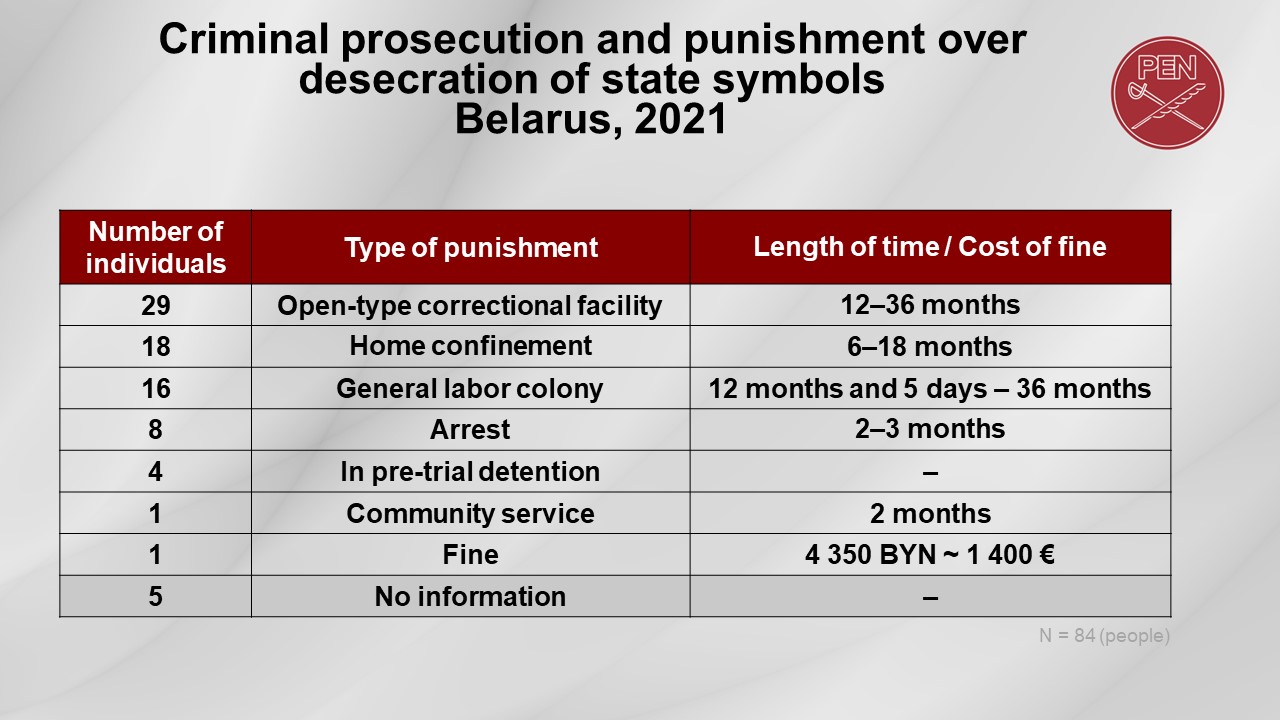
Those convicted in criminal cases also had to provide financial compensation for any material damage caused by their actions. Information about the extent of damage is not fully known; however, we can say that the fines of which we are aware range from 2 rubles 44 kopecks (“Viačaslaŭ Ulasievič removed a flag from a building on Lenin Street in Baranavičy, carried it for some distance, and threw it on the ground, causing the shaft to break into three parts.”) to 129 rubles (Daniil Papkoŭ “grabbed the flag” near 21 Savieckaja Street in Homel, “which caused damage to it...”).
DOUBLE STANDARDS
Part 9 of Article 8 of the Law of the Republic of Belarus, dated 05.07.2004, No. 301-3, “On State Symbols of the Republic of Belarus”, states: “It is forbidden to place inscriptions and graphics on the State Flag of the Republic of Belarus regardless of the method of their application.” Article 15 of the Law states that “violation of the requirements of the Law, as well as any abuse of state symbols of the Republic of Belarus, entail liability in accordance with legislation.” On October 31, 2021, the Telegram channel of the Belarusian Presidential Administration posted photos of an exposition from at The Independence Palace, which featured a National Flag of the Republic of Belarus with a portrait of a man (Lukashenko) and the inscription (“For the Father”) [5]. Citizens petitioned in demand of a legal assessment of such modification of the State Flag of the Republic of Belarus, in accordance with the aforementioned article sections and statutes. The Minsk Prosecutor’s Office ignored this appeal and did not consider its merits.
ADMINISTRATIVE CASES
During the period of monitoring, 4 administrative cases initiated against fans of hockey and football matches for “illegal actions involving the state symbols of the Republic of Belarus” (Article 24.54 of the updated Administrative Code) occurred. In Hrodna the accused failed to stand during the performance of the national anthem before the start of the hockey match against the Neman team, thereby violating regulations (the results of the administrative hearings in this case are not yet known). Also, a Slonim resident who got carried away watching videos on his phone at the start of a football match and got up about 15 seconds after the anthem began was fined 290 rubles (approximately 94 euros as of the end of 2021).
III. A SYMBOLIC FIGHT IN CITY SPACE
Across the capital of Belarus, one slogan accompanying the peaceful marches of summer and fall 2020 sounded like this: “This is our city!”. As they became part of the protest movement, participants gained civil subjectivity for the first time in their lives, and, showing it, began to actively claim urban space for themselves on a symbolic level. For the duration of the protest movement, large and small cities alike blossomed with red and white street art and art objects. However, in its unequal struggle with the repressive state apparatus, the protest movement was forced to go underground; then, local authorities used administrative resources to destroy all signs of red-and-white free expression, painting over everything with the colors of the official, red and green flag. Hence the space of each city became a place of symbolic struggle between a democratically minded civil society and the followers of an authoritarian regime. Municipal services in Minsk and other regions dismantled red and white inscriptions; they painted over or repainted street art, graffiti, officially authorized murals, water towers, chimneys, the red stripes on concrete mixers, sidewalks, and asphalt. All the while, authorities “ennobled” neighborhood yards by painting benches, trash cans and entrance doors red and green. They massively modified the color of steles that mark off areas or stand at the entrance to Belarusian cities. Everywhere, they identified themselves by hanging the official flag of the country: on the buildings of supermarkets, industrial stores, banks, and other institutions.
The war against symbols has been waged on numerous fronts. For example, school administrations secretly forbade graduates from appearing at their graduations and celebrations in red and white ribbons, but actively invited schoolchildren to participate in a patriotic action called “#TheColoroftheHomeland” (#ЦветаМоейРодины). In March, residents of Minsk, Mahilioŭ and Brest received atypical utility bills: on the back of the bill, there was both an invitation to take part in a traditional landscaping campaign, and also several paragraphs on the topic of “Don’t let yourself be fooled: Myths about the white-red-white flag”. The passage called the white-red-white flag a symbol of traitors and executioners. Over time, official symbols in public city spaces have been supplemented with Russian and Soviet ones. For example, at pro-government car rallies, Russian flags appear alongside the red and green flags, and at subbotniks, individuals sometimes wear badges with Lenin’s face on them. Soviet symbols also appear in other places: for example, a red Soviet with a hammer and sickle was added to the state flag on a number of shops and other institutions in the capital of Brest Region.
Against the backdrop of shop-owners selling national [white-red-white] symbols and facing pressure to shut down their stores, “according to numerous wishes of city residents” in Mahilioŭ, a store was opened to sell state symbols “with the national color”…
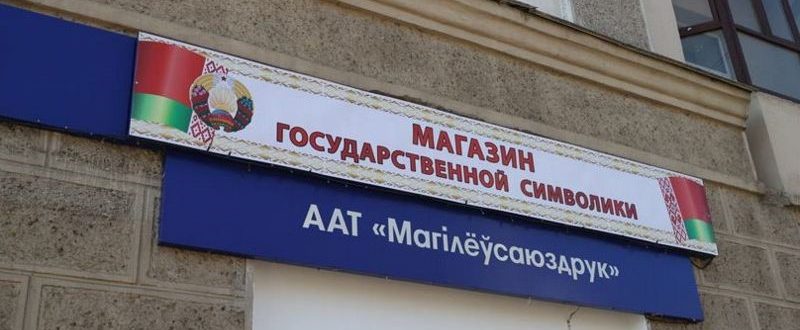
IN 2021, DURING THE SYMBOLIC FIGHT ACROSS THE CITIES OF BELARUS:
They painted over and repainted white and red
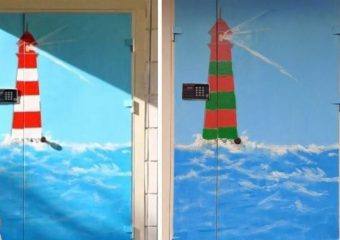
In February, an officially authorized mural called My country Belarus (Мая краіна Беларусь), painted in 2017 on the wall of a electrical substation on Dunin-Marcinkevich Street in Minsk, was painted over with red ornamentation in the Belarusian national style. In April, a white and red lighthouse featured among the graffiti in the Maladziečana art yard was repainted to be red and green. In the same month, residents of the Uručča microdistrict in Minsk drew attention to how a famous Zmiej Harynyč sculpture that had been painted white and red after the 2020 elections was suddenly gray. A once-white-and-red chimney of the Brest thermal power plant, located near a stadium, was also transformed in several stages (in accordance with aviation safety rules). First, in April, the ornamentation of the official national flag was applied to it; then, the chimney began to “turn green”, and finally transformed into a full red and green flag. In May, the colors were supplemented with night lighting. Changes have also occurred on the facade of the new Palazzo shopping and entertainment complex, located not far from the Independence Palace in Minsk—the white and red facade above the entrance was repainted to be red and orange. In the center of Sluck, a passage in front of a shopping center was decorated in white and red colors, but on the eve of May 9, the red stripes were quickly painted over with black. Support beams on a train bridge were repainted by the Babrujsk municipal services from white and red to white and yellow. Also, Orthodox priest Alaksandr Šramko noted that the white-red-white ribbon on the coat of arms of the Hrodna diocese was replaced with the color purple.
They modified steles en masse


Red and green became the background-color scheme for the entrance stele in the city of Biaroza, while the entry sign to the agricultural city of Malech in Brest Region is now entirely red and green. As part of the annual all-republic Subbotnik day, the white and red “Brest Region” sign on the border between the Brest and Homel regions was remained blue. The stele at the entrance to Bielaaziorsk was repainted by regional officials from white and red to green and red. In the Hrodna Region, in the city of Masty, there is a monument in memory of local residents who had died in the Second World War; it had not been repainted since the 1970’s, but in 2021, it was painted red and green. The entrance stele to the city of Uzda, in Minsk Region, was also changed from red and white to red and green. The white-red “Pahonia” on the official coat of arms of Mahilioŭ, placed among the coat of arms of all regional centers in Belarus as depicted on a stele on the Avenue of the Republic in Brest, was painted over with just white to make it less conspicuous. And this list is not complete.
They hung red and green flags and banners

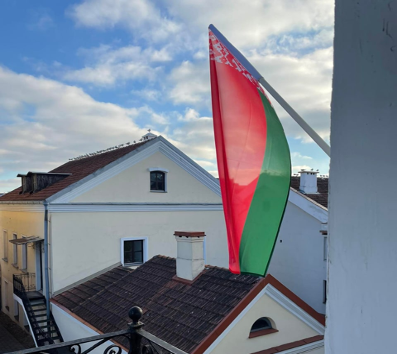
Red-green flags were starting to be hung from the tops of buildings, and representatives of the Ministry of Emergency Situations did not see any problem with this from a safety perspective—despite how they had fined many civilian residents when they had done the same with white-red-white flags, citing illegal use of “products made of combustible textiles”. In February, a 10 x 35 meter banner was hung from an executive committee building in Babrujsk; the banner cost 5700 Rubles from the local budget (about 1840 Euros). In April, strips of red and green fabric were hung from the Hrodna trolleybus department building, right in front of the office windows.
Flags began to appear on the roofs of residential homes, especially in the areas of Minsk with the most protests, where residents had presented white-red-white flags in their windows. In March, a red-green flag was hung from the roof of residential buildings in the “Novaja Baravaja” and “Cascade” residential complexes. The flagpoles of stores, culture buildings, and various other institutions have been “blowing up” with red-green flags since 2020.
On Victory Day (May 9), They Celebrated the Day of the Flag and the Emblem


In 2021, Government Symbols Day (the second Sunday in May), which was previously not a special celebration, coincided with Victory Day — and this made for a double holiday for the celebration of red and green symbols. Based on the accounting, it was evident that 2,000 red and 2,000 green balloons, along with helium and pyrotechnics, were purchased for “Minskkonsert,” because of the requirement that “the prevailing color scheme will be the national colors of the Republic of Belarus.” A solemn removal and raising of the national flag of Belarus also took place on Lenin Square in Brest, where the flagpole was joyously presented at the Kryčaŭ police department. Police, investigators, rescue workers, and veterans lined up at the site and took part in the event.
Blue is the New Red


One tendency from 2021 whose development will be important to follow in the future is the tendency to replace the traditional use of red with blue. For example, such a replacement occurred in the folk costumes of participants in the Holiday of National Unity (established in 2021) in Orsha. Blue was also the main color on the uniforms worn by the Belarusian team at the Beijing Olympics in 2022. At a December holiday procession in Homel, the vast majority of Ded Morozes and Snegurochkas were in blue costumes, and with the same blue bag and blue crozier, another Ded Moroz strolled through the Minsk Metro.
It is impossible to say unequivocally what this phenomenon suggests, the extent to which it is intentional, and what pitfalls it may carry. When authorities announced the results of a contest to create the logo for the Year of National Unity, they selected an image “using elements of Belarusian ornamentation and the color of cornflowers, a symbol of Belarus” as the best. One must not forget that a characteristic feature of official administrative representatives of the Belarusian regime is the regular presence of double standards and maximal discrepancies between what is said and what is implied. Could it be that the transition to blue is actually connected to the displacement of red and its replacement with something less conspicuous? Or is this color being introduced into public space as a symbol of the Russian “tricolor” flag, which is blue and white and red? There is no clear answer, but nonetheless, the trend has emerged.
CONCLUSION: WHITE-RED-WHITE FLAG AND LEGISLATION
On one hand, there is no legislative ban on the use of the white-red-white flag. On the other hand, a flag hanging on a balcony is seen by the authorities as an act “prohibited by legislative statutes”. According to Article 24.26 of the new version of the Administrative Code of the Republic of Belarus, which has been enforced since March 1, 2021, such prohibited acts are punishable by a fine of up to 580 rubles (about 190 euros) for individuals, 1,160 rubles (375 euros) for entrepreneurs, and 1,740 rubles (560 euros) for legal entities. Before the updated Administrative Code, hanging a white-red-white flag on the balcony was regarded as an unauthorized protest. At the same time, throughout the year, government agencies have regularly raised the question of whether or not to mark the white-red-white flag as “extremist.” First, on January 29, the Prosecutor General’s Office accepted a collective “appeal of more than 100 citizens” for consideration; the appeal requested that authorities classify the flag as an extremist symbol. A counter-petition created by the Coordinating Council against the recognition of the flag as extremist has collected more than 100,000 signatures.
In February, the House of Representatives and other authorities received petitions against the recognition of the white-red-white flag as extremist. In the petitions, professional historians and teachers of historical disciplines, local historians, graduates of historical faculties, and students celebrated the spiritual and moral value of the flag for millions of Belarusians regardless of political views. Later, on May 21, the Ministry of Internal Affairs (MIA) of Belarus proposed to include the flag in the list of Nazi symbols, and on June 21, the MIA sent a document with a list of Nazi symbols and paraphernalia to the State Security Committee (KGB) for approval. The list included a white-red-white flag and the slogan “Long Live Belarus!”. On July 26, General Prosecutor Andrei Shved announced that his team had finished preparing materials “for an appeal to the Supreme Court in order to recognize these materials as extremist symbols.”
As of the end of 2021, the white-red-white flag does not appear in the list of extremist materials, and the Administrative Code does not specify what a “prohibited flag” is—but judging by the fines for using the white-red-white flag, its use is still illegal. Indeed, the white-red-white is tacitly prohibited, and its use is punishable by law.

[2] From March 1, 2021, the “of the people” article 23.34 of the Code of Administrative Offenses became article 24.23.
[3] According to known to us, but incomplete information.
[4] According to known to us, but incomplete information.
[5] Pul Pervogo.
